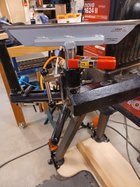Odie
Panning for Montana gold, with Betsy, the mule!
Every time I pick up a different turning tool, I find myself adjusting the tool rest height, according to presentation of the cutting edge to the spindle centerline, while the tool itself is held level. This is a theoretical application, since there are variables that may exist for changing applications. Regardless, this is my generic tool rest height standard setting, prior to further consideration of variables encountered by the specific application.
Theoretically, if the cutting edge is presented to the turning, at exactly central to the spindle centerline, a better cut is possible, but not a given. The changing distances between the top of the tool rest, plus the thickness of the current turning tool will make this point of contact vary, and the adjustment of tool rest height may be necessary. To further the variance, the tilt of the tool on the top of the rest (fulcrum) will make a difference, according to individual turning styles. If the tool rest height, considering the thickness of the tool, is below the spindle centerline, the tool itself can be presented with the tip tilting up on it's fulcrum, and still hit the spindle centerline exactly.....and the opposite is true with a the tool rest higher, while the tool tip is tilted down on it's fulcrum.
The standard, or generic rule of thumb is to have the cut slightly below centerline for exterior surfaces, and slightly above centerline for interior of bowls.....and this is a pretty good catch-all rule that handles a variety of situations, but isn't calculating for perfection in presentation at the centerline, while taking into consideration tool rest height, tool thickness and the turner's style of presentation.
We all want "the perfect cut", and tool rest height is only one of the variables that is needed for a perfect presentation of the cutting edge.
-----odie-----
Theoretically, if the cutting edge is presented to the turning, at exactly central to the spindle centerline, a better cut is possible, but not a given. The changing distances between the top of the tool rest, plus the thickness of the current turning tool will make this point of contact vary, and the adjustment of tool rest height may be necessary. To further the variance, the tilt of the tool on the top of the rest (fulcrum) will make a difference, according to individual turning styles. If the tool rest height, considering the thickness of the tool, is below the spindle centerline, the tool itself can be presented with the tip tilting up on it's fulcrum, and still hit the spindle centerline exactly.....and the opposite is true with a the tool rest higher, while the tool tip is tilted down on it's fulcrum.
The standard, or generic rule of thumb is to have the cut slightly below centerline for exterior surfaces, and slightly above centerline for interior of bowls.....and this is a pretty good catch-all rule that handles a variety of situations, but isn't calculating for perfection in presentation at the centerline, while taking into consideration tool rest height, tool thickness and the turner's style of presentation.
We all want "the perfect cut", and tool rest height is only one of the variables that is needed for a perfect presentation of the cutting edge.
-----odie-----
Last edited:

